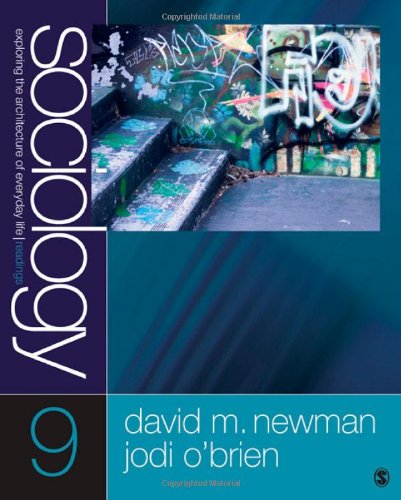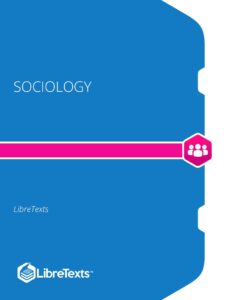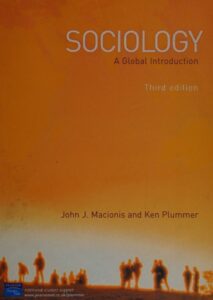Summary
In Sociology: Exploring the Architecture of Everyday Life, David Newman shows students how to see the “unfamiliar in the familiar”―to step back and see organization and predictability in their personal experiences. Through his approachable writing style and lively personal anecdotes, the author has maintained his goal from the first edition: to write a textbook that “reads like a real book.” Many adopters of this book are fans of Peter Berger′s classic works, which helped introduce the idea of “social constructionism” to sociology. Newman uses the metaphors of “architecture” and “construction,” to help students understand that society is not something that exists “out there,” independently of themselves; it is a human creation that is planned, maintained, or altered by individuals.
Providing provocative, eye-opening examples that illuminate the relationship between the individual and society, this Ninth Edition includes a mix of short articles, chapters, and excerpts. In addition to new readings and more coverage of global issues and world religions, the Ninth Edition focuses on sociological theory, methodologies and history to help students learn how to analyze what they read, as well as understand how research is done and how today’s theories have developed over time.
- Includes new readings that show how race, social class, gender, and sexual orientation intersect to influence everyday experiences
- Presents updated and expanded coverage of global issues and world religions
- explores topical issues such as environment, climate change, macro-structure, and post-9/11 conditions
- Provides an expansive discussion on sociological theory and methodologies.
Contents
Part I. The Individual and Society
Chapter 1. Taking a New Look at a Familiar World
- Reading 1.1. The Sociological Imagination
- C. Wright Mills
- Reading 1.2. Invitation to Sociology
- Peter Berger
- Reading 1.3. The My Lai Massacre: A Military Crime of Obedience
- Herbert Kelman and V. Lee Hamilton
Chapter 2. Seeing and Thinking Sociologically
- Reading 2.1. The Metropolis and Mental Life
- Georg Simmel
- Reading 2.2. Gift and Exchange
- Zygmunt Bauman
- Reading 2.3. Culture of Fear
- Barry Glassner
Part II. The Construction of Self and Society
Chapter 3. Building Reality: The Social Construction of Knowledge
- Reading 3.1. Concepts, Indicators, and Reality
- Earl Babbie
- Reading 3.2. Missing Numbers
- Joel Best
Chapter 4. Building Order: Culture and History
- Reading 4.1. Body Ritual among the Nacirema
- Horace Miner
- Reading 4.2. The Melting Pot
- Anne Fadiman
- Reading 4.3. McDonald’s in Hong Kong: Consumerism, Dietary Change, and the Rise of a Children's Culture
- James L. Watson
Chapter 5. Building Identity: Socialization
- Reading 5.1. Life as the Maid’s Daughter: An Exploration of the Everyday Boundaries of Race, Class, and Gender
- Mary Romero
- Reading 5.2. The Making of Culture, Identity, and Ethnicity Among Asian American Youth
- Min Zhou and Jennifer Lee
- Reading 5.3. Working “the Code”: On Girls, Gender, and Inner-City Violence
- Nikki Jones
Chapter 6. Supporting Identity: The Presentation of Self
- Reading 6.1. The Presentation of Self in Everyday Life: Selections
- Erving Goffman
- Reading 6.2. Public Identities: Managing Race in Public Spaces
- Karyn Lacy
- Reading 6.3. The Girl Hunt: Urban Nightlife and the Performance of Masculinity as Collective Activity
- David Grazian
Chapter 7. Building Social Relationships: Intimacy and Family
- Reading 7.1. The Radical Idea of Marrying for Love
- Stephanie Coontz
- Reading 7.2. Gay Parenthood and the End of Paternity as We Knew It
- Judith Stacey
- Reading 7.3. Covenant Marriage: Reflexivity and Retrenchment in the Politics of Intimacy
- Dwight Fee
Chapter 8. Constructing Difference: Social Deviance
- Reading 8.1. Watching the Canary
- Lani Guinier and Gerald Torres
- Reading 8.2. Healing (Disorderly) Desire: Medical-Therapeutic Regulation of Sexuality
- P. J. McGann
- Reading 8.3. Patients, “Potheads,” and Dying to Get High
- Wendy Chapkis
Part III. Social Structure, Institutions, and Everyday Life
Chapter 9. The Structure of Society: Organizations and Social Institutions
- Reading 9.1. These Dark Satanic Mills
- William Greider
- Reading 9.2. The Smile Factory: Work at Disneyland
- John Van Maanen
- Reading 9.3. Creating Consumers: Freaks, Geeks, and Cool Kids
- Murry Milner
Chapter 10. The Architecture of Stratification: Social Class and Inequality
- Reading 10.1. Making Class Invisible
- Gregory Mantsios
- Reading 10.2. The Compassion Gap in American Poverty Policy
- Fred Block, Anna C. Korteweg, and Kerry Woodward, with Zach Schiller and Imrul Mazid
- Reading 10.3. Branded With Infamy: Inscriptions of Poverty and Class in America
- Vivyan Adair
Chapter 11. The Architecture of Inequality: Race and Ethnicity
- Reading 11.1. Racial and Ethnic Formation
- Michael Omi and Howard Winant
- Reading 11.2. Optional Ethnicities: For Whites Only?
- Mary C. Waters
- Reading 11.3. Silent Racism: Passivity in Well-Meaning White People
- Barbara Trepagnier
Chapter 12. The Architecture of Inequality: Sex and Gender
- Reading 12.1. Black Women and a New Definition of Womanhood
- Bart Landry
- Reading 12.2. Still a Man’s World: Men Who Do “Women’s Work”
- Christine L. Williams
- Reading 12.3. New Biomedical Technologies, New Scripts, New Genders
- Eve Shapiro
Chapter 13. Global Dynamics and Population Demographic Trends
- Reading 13.1. Age-Segregation in Later Life: An Examination of Personal Networks
- Peter Uhlenberg and Jenny de Jong Gierveld
- Reading 13.2. Love and Gold
- Arlie Russell Hochschild
- Reading 13.3. Cyberbrides and Global Imaginaries: Mexican Women’s Turn from the National to the Foreign
- Felicity Schaeffer-Grabiel
Chapter 14. The Architects of Change: Reconstructing Society
- Reading 14.1. Muslim American Immigrants After 9/11: The Struggle for Civil Rights
- Pierrette Hondagneu-Sotelo
- Reading 14.2. The Seattle Solidarity Network: A New Approach to Working Class Social Movements
- Walter Winslow
- Reading 14.3. “Aquí estamos y no nos vamos!” Global Capital and Immigrant Rights
- William I. Robinson
Credits
Extract
One of the greatest challenges we face as teachers of sociology is getting our students to see the relevance of the course material to their own lives and to fully appreciate its connection to the larger society. We teach our students to see that sociology is all around us. It’s in our families, our careers, our media, our jobs, our classrooms, our goals, our interests, our desires, and even our minds.
Sociology can be found at the neighborhood pub, in conversation with the clerk at 7-Eleven, on a date, and in the highest offices of government. It’s with us when we’re alone and when we’re in a group of people. Sociology focuses on questions of global significance as well as private concerns. For instance, sociologists study how some countries create and maintain dominance over others and also why we find some people more attractive than others. Sociology is an invitation to understand yourself within the context of your historical and cultural circumstances.
We have compiled this collection of short articles, chapters, and excerpts with the intent of providing comprehensive examples of the power of sociology for helping us to make sense of our lives and our times. The readings are organized in a format that demonstrates.
- the uniqueness of the sociological perspective
- tools of sociological analysis
- the significance of different cultures in a global world
- social factors that influence identity development and self-management
- social rules about family, relationships, and belonging
- the influence of social institutions and organizations on everyday life
- the significance of socioeconomic class, gender, and racial/ethnic backgrounds in everyday life
- the significance of social demographics, such as aging populations and migration
- the power of social groups and social change
Author
David M. Newman earned his BA from San Diego State University in 1981 and his graduate degrees from the University of Washington in Seattle (MA 1984, PhD 1988). After a year at the University of Connecticut, David taught at DePauw University for more than 30 years. He currently teaches at Colgate University. David teaches courses in contemporary society, deviance, mental illness, family, social inequality, and research methods. He has published numerous articles on teaching and has presented research papers on the intersection of gender and power in intimate relationships.
Recently most of his scholarly activity has been devoted to writing and revising several books, including Sociology: Exploring the Architecture of Everyday Life: Brief Edition (SAGE, 2020); Identities and Inequalities: Exploring the Intersections of Race, Class, Gender, and Sexuality (McGraw-Hill, 2021); and Families: A Sociological Perspective (McGraw-Hill, 2009). His most recent book, A Culture of Second Chances: The Promise, Practice and Price of Starting Over in Everyday Life (Lexington Books, 2019), examines the cultural meaning, institutional importance, and social limitations of “second chance” and “permanent stigma” narratives in everyday life. (Sage Publications Ltd.)
Jodi O’Brien (PhD, University of Washington) is Professor of Sociology at Seattle University. She teaches courses in social psychology, sexuality, inequality, and classical and contemporary theory. She writes and lectures on the cultural politics of transgressive identities and communities. Her other books include Everyday Inequalities (Basil Blackwell), Social Prisms: Reflections on Everyday Myths and Paradoxes (SAGE), and The Production of Reality: Essays and Readings on Social Interaction (5th edition, SAGE).
Book Details




